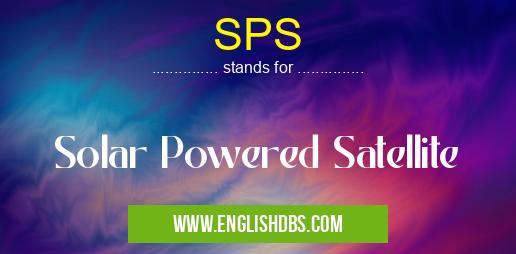What does SPS mean in
SPS (Solar Powered Satellite) is a concept for a satellite that would collect solar energy and transmit it back to Earth in the form of wireless power. The idea of SPS has been around for decades, and it has been the subject of research and development by various organizations.

SPS meaning in in Academic & Science
SPS mostly used in an acronym in Category Academic & Science that means Solar Powered Satellite
Shorthand: SPS,
Full Form: Solar Powered Satellite
For more information of "Solar Powered Satellite", see the section below.
SPS Meaning in Science
In the context of science, SPS refers to a satellite that is equipped with large arrays of solar panels to convert solar energy into electricity. This electricity is then converted into microwaves or lasers, which are then transmitted to Earth using high-power antennas. The microwaves or lasers are then received by ground-based receivers, where they are converted back into electricity.
SPS Full Form
The full form of SPS is Solar Powered Satellite.
What does SPS Stand for
SPS stands for Solar Powered Satellite.
How does SPS Work
SPS works by converting solar energy into electricity, which is then transmitted to Earth in the form of microwaves or lasers. The microwaves or lasers are received by ground-based receivers, where they are converted back into electricity.
Advantages of SPS
- Clean and renewable energy source: SPS would provide a clean and renewable source of energy, as it would not produce any greenhouse gases or other pollutants.
- Reliable energy source: SPS would provide a reliable source of energy, as it would not be affected by weather conditions.
- Reduced transmission losses: SPS would reduce transmission losses, as the power would be transmitted wirelessly.
Challenges of SPS
- High cost: SPS would be a very expensive project to build and launch.
- Technical challenges: SPS would require a number of significant technical challenges to be overcome, such as the development of high-efficiency solar cells and high-power antennas.
- Environmental concerns: SPS could have a number of environmental impacts, such as the potential for microwave interference with wildlife.
Essential Questions and Answers on Solar Powered Satellite in "SCIENCE»AEROSPACE"
What is a Solar Powered Satellite (SPS)?
An SPS is a satellite that converts sunlight into electricity using photovoltaic panels and then transmits the electricity to Earth via microwave or laser beams.
What are the benefits of SPSs?
SPSs have several potential benefits, including:
- Renewable and sustainable energy source
- Continuous power generation, even during nighttime or cloudy conditions
- Reduced dependence on fossil fuels and lower greenhouse gas emissions
- Potential for large-scale power generation
What are the challenges of SPSs?
SPSs also have some challenges, such as:
- High cost of construction and deployment
- Technical challenges in efficient energy conversion and wireless power transmission
- Concerns about space debris and environmental impact
How do SPSs work?
SPSs consist of several components:
- Solar panels to convert sunlight into electricity
- Antenna to transmit electricity to Earth
- Power beaming technology (microwave or laser)
- Ground receiving station to collect the transmitted electricity
Are there any SPSs currently in operation?
Currently, there are no operational SPSs. However, several research and development projects are underway to explore the feasibility and potential of SPS technology.
What is the future of SPSs?
The future of SPSs depends on technological advancements, cost reduction, and addressing environmental and safety concerns. If these challenges can be overcome, SPSs have the potential to become a significant source of clean and sustainable energy.
Final Words: SPS is a promising concept for a clean and renewable source of energy. However, there are a number of challenges that need to be overcome before SPS can become a reality.
SPS also stands for: |
|
| All stands for SPS |
